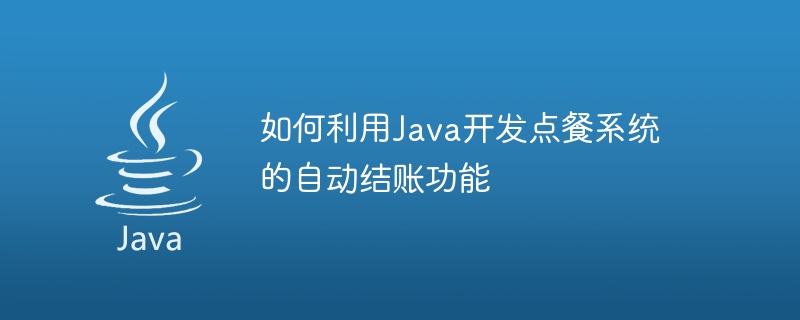Home >Java >javaTutorial >How to use Java to develop the automatic checkout function of the ordering system
How to use Java to develop the automatic checkout function of the ordering system
- WBOYWBOYWBOYWBOYWBOYWBOYWBOYWBOYWBOYWBOYWBOYWBOYWBOriginal
- 2023-11-01 11:49:58892browse

How to use Java to develop the automatic checkout function of the ordering system
1. Introduction
In today's fast-paced life, people are interested in the convenience of the ordering system Safety and efficiency requirements are getting higher and higher. The automatic checkout function is an indispensable part of the ordering system, which can greatly improve the customer's dining experience and the hotel's work efficiency. This article will introduce how to use Java to develop the automatic checkout function of the ordering system.
2. System Requirements Analysis
- Automatically calculate the consumption amount: After the user orders a meal, the system needs to automatically calculate the consumption amount based on the quantity and unit price of the dishes.
- Support preferential discounts: The system needs to support automatic calculation of discount amounts based on promotional activities or membership levels.
- Automatically generate a bill: The system needs to automatically generate a statement based on the consumption details, including various fees and discounts.
- Support multiple payment methods: The system needs to support multiple payment methods, such as Alipay, WeChat Pay, bank cards, etc.
- Update inventory quantity: The system needs to update the inventory quantity of dishes in a timely manner for subsequent management and statistics.
3. System design and implementation
- Data model design: Based on system demand analysis, it is necessary to design data models for dishes, orders, bills, etc., and establish corresponding database tables structure.
- User interface design: Design a user-friendly ordering interface through frameworks such as Java Swing or JavaFX, including menu display, quantity selection, discount options, etc.
- Automatically calculate the consumption amount: In the ordering interface, after the user selects the number of dishes, the system calculates the consumption amount based on the unit price and quantity of the dishes, and displays it to the user in real time.
- Support discounts: The system automatically calculates the discount amount based on promotions or membership level settings and displays it in the checkout.
- Automatically generate a bill: After the user clicks the checkout button, the system automatically generates a bill based on the consumption details, including various fees, discounts and final payment amount.
- Support multiple payment methods: Multiple payment methods are provided in the checkout, and users can choose the appropriate payment method to pay according to their needs.
- Update inventory quantity: After the user places an order, the system needs to update the dish inventory quantity in a timely manner for subsequent management and statistics.
4. Key technologies and implementation methods
- Java language: Use Java language to develop the ordering system to ensure the stability and scalability of the system.
- Database management: Use a relational database, such as MySQL, to manage data such as dishes, orders, and bills.
- Business logic processing: Utilize the object-oriented features of Java to encapsulate business logic into classes and methods to implement various functions of the ordering system.
- User interface design: Use frameworks such as Java Swing or JavaFX to implement a user-friendly ordering interface and improve the user's operating experience.
- Database operation: Use JDBC or ORM framework such as Hibernate to perform database addition, deletion, modification and query operations to ensure data consistency and accuracy.
- Payment interface integration: Use the SDK of the third-party payment interface to realize the integration of multiple payment methods, such as Alipay, WeChat payment, etc.
5. System testing and optimization
- Unit testing: Unit testing of each functional module of the ordering system to ensure the correctness of the functions.
- Integration test: Test whether the integration of the ordering system and the third-party payment interface is normal.
- Performance optimization: Conduct performance testing on the ordering system and perform targeted optimization to improve the system's response speed and concurrent processing capabilities.
- Security optimization: Add appropriate encryption and verification mechanisms to the payment function to ensure the security of the payment process.
6. Future development direction
- Mobile application: The ordering system will be transplanted to the mobile terminal to facilitate users to order and check out anytime and anywhere.
- Cloud deployment: Deploy the ordering system to the cloud to achieve cross-platform and scalability of the system.
- Data analysis and marketing: Make accurate recommendations and personalized marketing through data analysis and user behavior statistics.
7. Conclusion
This article introduces how to use Java to develop the automatic checkout function of the ordering system. Through reasonable system design and the application of key technologies, functions such as automatically calculating consumption amounts, supporting discounts, automatically generating bills, supporting multiple payment methods, and updating inventory quantities can be realized. This system can improve customers' dining experience and hotel work efficiency, and also provides some ideas and directions for future development and improvement.
The above is the detailed content of How to use Java to develop the automatic checkout function of the ordering system. For more information, please follow other related articles on the PHP Chinese website!
Related articles
See more- Java error: Reasons and solutions for main class not found or unable to be loaded
- MySQL implements the dish taste management function of the ordering system
- Detailed explanation of the menu supplier management function in the Go language development ordering system
- How to use PHP to develop the member login function of the ordering system?
- MySQL implements the dish classification management function of the ordering system

